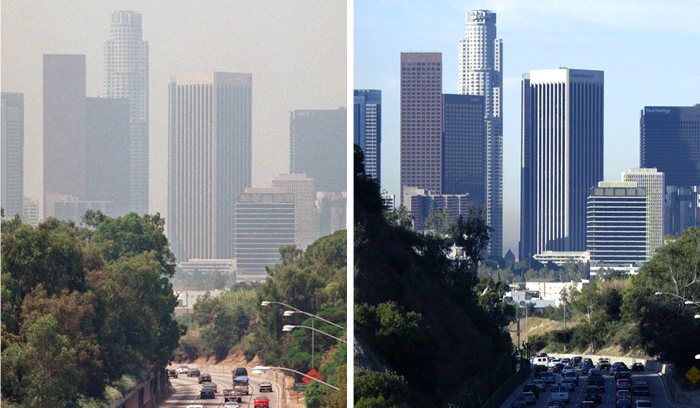Decreased air pollution resulting from COVID-19 is only temporary unless steps are taken
Before and after photo of the Los Angeles skyline. Stay at home measures are not only protecting people’s health but the health of the environment.
May 15, 2020
As a result of COVID-19, there have been many positive changes in the environment not only in the U.S. but across the globe. Air pollution, specifically from nitrogen dioxide, has decreased in the northeastern U.S. by 30%, according to CNBC. This type of pollution is primarily influenced by car and truck emissions, and now that people are advised to stay at home and practice social distancing, these levels have decreased drastically.
Stay at home orders offer a rare opportunity for scientists to study the impacts of human transportation and emissions on the environment. The short term effects have already made huge strides for air quality in high transportation areas. Los Angeles, notorious for its smog and traffic, has seen improvement in recent weeks which is most likely tied to the coronavirus response.
“Before stay-at-home orders were issued March 16, the EPA’s Air Quality Index, which incorporates multiple air pollutants, including NO2 and PM2.5 (fine particulate matter), was about 60, or in the ‘moderate’ category,” said Yifang Zhu, a professor at UCLA’s Fielding School of Public Health, in an article for the Washington Post. “Since then, it has improved by about 20 percent and recorded the longest stretch of ‘good’ air quality in March seen since at least 1995.”
These changes, however, are only temporary. Once restrictions have been lifted, it is expected for transportation to increase and for emissions to return to previous levels unless further steps are taken to continue. But rising levels does not mean that the progress that has been made during this time has not been beneficial.
“Because transportation is the single biggest source of greenhouse gas emissions in the U.S., and because passenger vehicles account for about 60 percent of these emissions, the short-term effect on the nation’s carbon footprint could be significant,” said Madeleine Stone of National Geographic.
The results of decreased air pollution during this time could give us a glimpse of what the future, with clean energy, could look like for the U.S.
“The observed air-quality improvement in Los Angeles linked to the coronavirus should not be looked at as only possible during a disaster but rather something that society should strive for during normal times,” said Zhu.
This time has provided numerous opportunities for alternative communication and collaboration strategies. Instead of attending meetings in person, people will now consider attending via remote means. This will not only save money due to decreased travel costs but will also decrease the amount of air pollution due to transportation. Walking or biking to work or school or work is not only environmentally efficient but also a way to incorporate healthy activity into your day.
Even though times are onerous right now, it is important to recognize the positive outcomes that can come from our response to COVID-19.










Honu • Sep 15, 2020 at 4:51 pm
If you look at the before and after photos of the Los Angeles skyline you’ll noticed there is more traffic on the freeway in the “smog free” picture as compared to the smoggy picture.
Jamin • May 5, 2023 at 10:20 am
Did you notice the longer shadows in the cleaner one? Likely even with the shutdowns there was still some rush hour traffic and the road was still not big enough to handle the horde of cars trying to use it… Not a great thing to make cities around the needs of cars, there’s no winning the scale game.